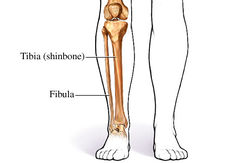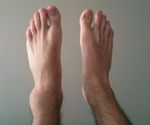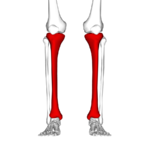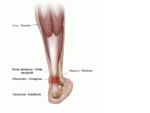Lower leg injury
Lower leg injuries include a variety of different types of injuries such as ankles sprain, muscle tears, and shin splints. These injuries can happen during activities, sports, or any type of physical movements. Lower leg injuries can occur in the tibia, fibula, lateral malleolus, or your calf muscles. There are many ways to avoid and treat these injuries that may require a doctor. Doctors can provide medicine, surgeries, therapy or anything else to help cure the injury. [1]
Ankle Sprain
Ankle sprains are when a ligaments of the ankle gets stretched or torn. This injury is extremely common that affects people during activities such as sports or any type of physical movement. Ankle sprains happen at least 25,000 times a day. This injury happens when the foot rolls under the ankle or leg and people usually complain about the pain outside of the ankle. When the injury happens there can be swelling and bleeding under the skin.[2] Ankle sprains can be diagnosed by x-rays. X-ray’s are machines that produces a beam of radiation that is directed at the area being examined, that involves an image of the inside of your body.[3]
Treating your ankle in a proper way can prevent pain. The four most important steps for recovering a sprained ankle is resting, icing, compression, and elevating. Surgery is not required for sprained ankles. Rest your ankle by not walking on it and putting no pressure on it. Ice the injured area 20 minutes every two to three hours. Compression helps control the swelling. Last but not least, elevate the foot by putting it above waist. Physical therapy also helps with strengthening the muscles that are surrounded the ankle. Recovery on sprains may take weeks; depending on the injury, ankles heal differently. [4]
Shin Splits
Shin splints are a member of a group of injuries call overuse injuries. When a person receives a shin split, the injury is always in the front of the the outer leg. The pain is found on the outer edge of the mid region of the leg next to the shinbone (tibia). During the pain, shin splints seem to result from inflammation due to injury of the soft tissues in the front of the outer leg. When a person gets injured shin splits can get mistakenly diagnosed by two different conditions. One of the conditions may be compartment syndrome. Compartment syndrome pain is on the anterior part of a lower leg, that causes swelling of muscles with closed compartments that makes pressure. Having pain in the lower leg can also be stress fracture. Stress fracture are more serious than shin splits, because it is an incomplete crack in the bone. Sometimes bones scans are the only definitive tool for diagnosing a stress fracture. When a person experiences a shin split, mornings are one the worst times when it occurs because in the morning the soft tissue tightens overnight. Also, shin splits are extremely painful when you try to lift your foot up at the ankle and flex your foot.[5]
Shin splits are very common in the world. People such as runners or dancers get them. Basically any activity with running, can cause a shin split. There are many ways shin splits can get treated. If you experience a shin split is is always good to go see a doctor first. The doctor will look through your leg and see whats wrong, and might need x-rays or scans to look for any fractures. One of the first steps on treating your shin split is resting your body. The ice your shin to ease swelling or pain. Ice for about 20 minutes every 4 hours for 2 to 3 days until you feel no pain. If you are experiencing more pain than you expected take medicine such as ibuprofen, naproxen, or aspirin. Do some exercises to stretch out your legs. Go to a therapist to identify your issue with your leg, because therapist can help ease the pain.[6]
Calf Muscle Tears
Pain that happens in the calf muscle, lower part of the leg is usually defined as a torn or pulled muscle. The calf muscle group is made of two muscles, the Gastrocnemius muscle that is the big muscle at the back of the lower leg and the Soleus muscle which is a smaller muscle lower down in the leg and lies underneath the gastrocnemius. Torn calf muscles are very similar to ruptures or Achilles tendon tears, but happens higher up in the back of the leg. People with calf muscle tears feel or hear a pop, and than pain, swelling or bruising notes pretty quickly. Calf injuries happen of a sudden pushing off movement or from over stretching of muscles as in running, jumping activities or quick movements in any direction. The main reason why calf muscle tears happen, is because of muscle tightness. Active people don't have problems if they stretch before. Stretching before any exercises and have good muscle strength prevents tears or calf injuries. [7]
Calf muscle tears happen during sudden muscular contraction such as playing some kind of sport, Basketball, football, tennis, or soccer. Also just running or walking to a bus can cause a calf muscle tear. When a person experiences a calf muscle tear, it is always important to rest, ice, compression, and elevate it for it to heal. Apply ice for 10 to 15 minute every hour until the pain is gone. Than wrap it, to help stop any internal bleeding. It is good to use some time of compression bandages, calf supports or sleeves. These supporters can immediately help stop swelling but only used for 10 minutes at a time, because the blood might flow to the tissues and could cause more damage. Wearing heel pads can help by raising the heel and shortening the calf muscle. It's always good to wear heel pads on both legs so that one leg won't become longer than the other due to the raised heel and the balance. Going to the doctors is also a good idea for treatment. Doctors can assign medication or any therapy sessions to make the pain go away. [8]
Video
A man describes and shows the common injuries to lower leg, ankle and foot.
References
- ↑ Lower leg injuries and conditions "uconnsportsmed" Web. Accessed 8 March, 2017. Unknown Author.
- ↑ How to care for a sprained ankle “aofas” Web. Accessed 8 March, 2017. Unknown Author.
- ↑ About X-rays "Acrin" Web. Accessed 8 March, 2017. Unknown Author.
- ↑ Ankle Sprain “aofas” Web. Accessed 8 March, 2017. Unknown Author.
- ↑ Shin Splits "Runner's world". Accessed 19 March, 2017. Unknown Author.
- ↑ Shin Splits "WebMd". Accessed 19 March, 2017. Unknown Author.
- ↑ Calf Muscle Tear "Physio Works". Accessed 19 March, 2016. Unknown Author.
- ↑ Calf Strain "Sports Injury Clinic". Accessed 19 March, 2017. Unknown Author.
| ||||||||||||||||||||




